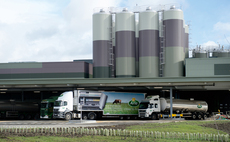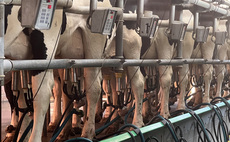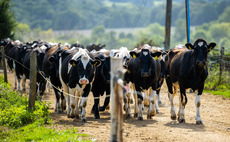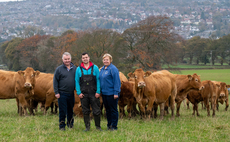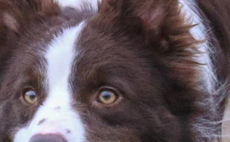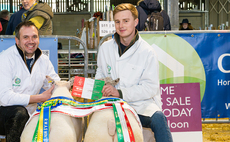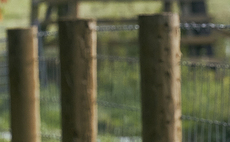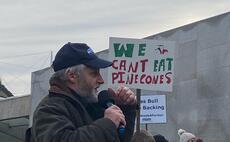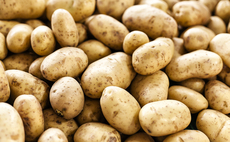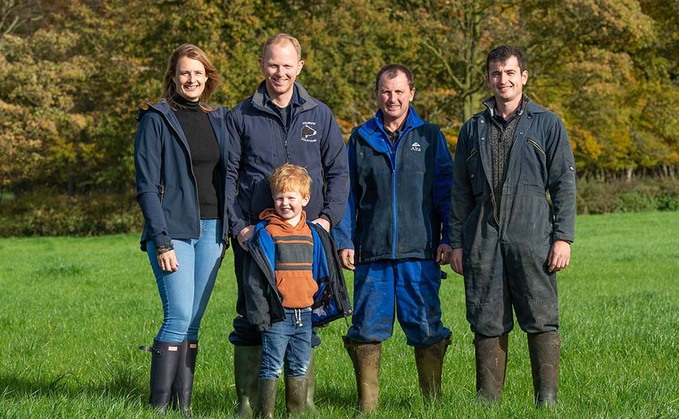
The 2020 National Milk Records/The Royal Association of British Dairy �������� Gold Cup will be awarded as part of the Dairy-Tech online event early next year and marks the 100th year of the award. Hannah Noble caught up with a family who has had considerable success in the competition over the years.
Since winning the Gold Cup in 1966 the renowned Bilsrow herd of Holsteins has been a finalist on four occasions and a runner-up three times.
However for James Tomlinson and wife Eleanor, winning is not the sole motivation for taking part. They use the competition as a perfect opportunity to benchmark their business and glean advice from leaders in the dairy industry and encourage others to do the same.
Established in 1920, the NMR/RABDF Gold Cup as we now know it, was originally presented by feed company R. Silcock and Sons and was one of four national dairy herds' competitions which were run by the National Dairy Herds Association. RABDF took responsibility for the competition in 1968 and in 1995 joined with NMR.
James Tomlinson says: "Most people would have given up by now but the competition is judged by such knowledgeable people and having them cast a critical eye over our business is a good thing. The main reason for entering competitions is for us to improve ourselves."
The Tomlinson family has called Bilsborrow Hall Farm, Bilsborrow, Lancashire, home since 1928 when Mr Tomlinson's grandfather Bill arrived by horse and cart from Westmorland and formed the Bilsrow herd of British Friesians, making it one of the oldest remaining herds in the country.
Transition
When the family won the Gold Cup in 1966, the herd was 80-strong and the genetics were still based on the original British Friesians. But in the late-1980s Mr Tomlinson's father, David, made the transition from Friesian to Holstein by importing a number of cows from Canada and France.
Mr Tomlinson says: "The production difference between the breeds drove the change and by the mid-1990s the herd was entirely Holstein."
Mrs Tomlinson, whose maiden name is Drinkall, hails from the long-established Pennine herd of Holsteins at Abbeystead, Lancashire. In 2017 James and Eleanor formed a limited company and took on the farm in their own right.
Mr Tomlinson is the fourth generation of the family to run a dairy herd at the farm which now comprises 300 pedigree Holsteins, with 260 in the milking herd.
The average Profitable Lifetime Index of the herd is +£200 and still includes cows descended from original families imported in the 1980s.
Mr Tomlinson says: "The Olympia family is our strongest cow family now with Bilsrow Grafeeti Olympia classified EX96.
There is also the Rolls family which was the first we got into and it is still one of our main cow families. Both came from France. And from Canada we still have members of the Roxy, Shower and Laurie Sheik families in the herd."
Mr Tomlinson says his real interest lies in genetics and as well as writing a magazine column on the subject, he hand selects all the bulls used on-farm. He looks for a balanced linear when choosing bulls and pays special attention to sire stacks and cow families. He uses a combination of proven and genomic bulls, leaning 70:30 towards genomics.
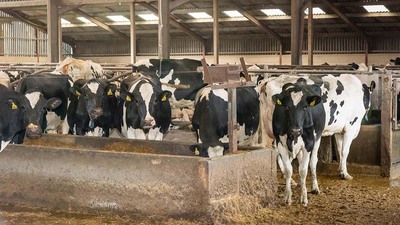
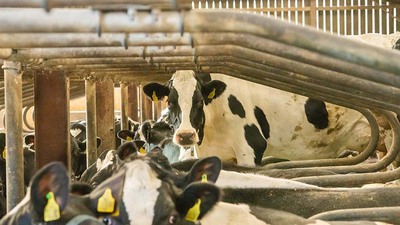
quote 1
"The competition is judged by such knowledgeable people and having them cast a critical eye over our business is a good thing."
- James Tomlinson
genomic bulls
Genomic bulls
"I think the genomic bulls tend to stick around in the rankings for longer if they have the backing of deep cow families and sire stacks," he says.
Getting the basics, of legs, feet and udders right is important to Mr Tomlinson and he looks for a balanced linear with no extremes for any individual traits. He says he looks for a maximum predicted transmitting ability (PTA) for Type Merit of +1.5-2.
"In the late 1980s and early 1990s when we changed to Holstein the focus was too heavily on production - everyone made the same mistake. The cows got too big and narrow and they just fell apart.
"The bigger a cow is the harder it finds it to live in a cubicle environment and so if it is stuck in the cubicles or lame it will not be eating what it needs to."
Mr Tomlinson says he puts a lot of weighting on health traits when selecting bulls to use on the herd, with fertility index and somatic cell count at the top of the list.
"Genomics has given everyone so much more choice, you do not need to entertain using bulls with negative FI index or positive cell counts. As a result of this, the SCC of the herd is running at 90,000 cells/ml. "
He says any bull used on the herd must have a PTA of more than 500kg of milk and currently the cows achieve an average lactation yield of 11,200kg at 4.2 per cent fat and 3.2 per cent protein.
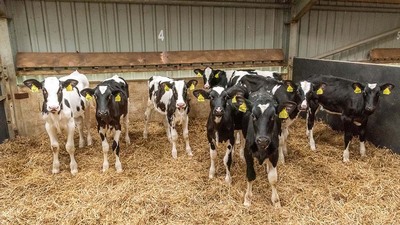
Three to four surplus heifers are sold through Lancaster Auction Mart each month.
Milk contract
Milk contract
This focus on components comes from their current milk contract with Lancashire Farm Dairy which requires high levels of fat and protein and at least 150 days of free-range grazing. However, they will start a new contract in January with Dewlay Cheesemakers, Garstang.
With plans to increase cow numbers, Mr Tomlinson says he thinks it is unfeasible to have a set target for grazing with the high annual rainfall in Lancashire. He says although they manage it with 260 cows in the milking herd, with any more cows it will be an unrealistic target.
"We have been on this contract for three years and previous to this the cows were housed all-year-round. Without a doubt management of cell counts and fertility in summer is far harder when the cows are out at grass. We are still aiming to graze some of the cows but without the pressure," he adds.
Mrs Tomlinson says: "The consumers love to see the cows in the field and so do we and the cows love it too, but it is a case of trying to keep a high level of efficiency while you are doing it."
Driven by feedback and help from the Gold Cup judging process, the Tomlinsons plan to put up a new building in spring 2021 which will house a new 40:40 rapid exit parlour and a host of new sand cubicles. Their aim is to increase cow numbers to 450.
Gold Cup finalists
THE Finalists for the 2020 NMR/RABDF Gold Cup are:
- John and Rachel Downing, The Downing Partnership, Edenbridge, Kent
- Jonathan Gibbins, Clyst Hydon, Cullompton, Devon
- Mark Hoskins, Hoskins and Vickery, Hindon, Salisbury, Wiltshire
- Joe Ives, W. and P. Ives, Herriard, Basingstoke, Hampshire
- Mike Sainsbury, R.P. Sainsbury and Sons, Badminton, Gloucestershire
- John Torrance, R. Torrance and Son, Stapleford Abbotts, Essex
quote
"As we transition from the old parlour to the new one, I am hoping we should be able to milk another 100 cows in the same time."
- James Tomlinson
Cow numbers
Cow numbers
Mr Tomlinson says: "Because we are pushing up cow numbers, and as we transition from the old parlour to the new one, I am hoping we should be able to milk another 100 cows in the same time with the same labour requirement."
The expansion has been planned for a number of years and Mr Tomlinson says with their heavy use of sexed semen there are plenty of heifers coming through to help with the growth of the herd.
"We are planning by September or October next year to have a big batch of heifers calving to go straight into the new parlour. It will be easier for them not having to learn two parlours."
As well as having enough heifers to allow expansion of the herd, Mr Tomlinson hopes it will allow them to continue selling fresh calved heifers each month.
The heifers are sold through Lancaster auction mart and their aim is to sell three or four a month.
He says: "Selling surplus heifers helps with cashflow and we want to keep doing that because we have a good following both at home and in the market. Last month we sold one for £2,900 which went to a local breeder, trade is really good at the minute."
Mr and Mrs Tomlinson have three children, William, six, George, four and Edith, three, and as they do a lot of the work on the farm themselves, they say getting the balance right between the farm and the children is really important to them.
Mrs Tomlinson adds: "The children are a massive focus to us. We have to give them and us the memories, what is the point in having kids if you do not want to do anything with them?"
pic2
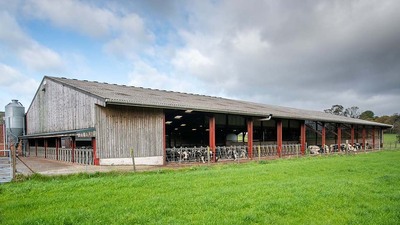
The Tomlinsons plan to put up a new building in spring 2021 housing a new parlour and sand cubicles.
Farm facts
- Bilsborrow Hall Farm is 87 hectares (215 acres) and is combined with a further 89ha (220 acres) which have been bought in the last 10 years
- The herd's calving index is 382 days, but Mr Tomlinson prefers to use the 100-day in-calf rate as a metric to benchmark against and it is currently 48 per cent
- Average days in-milk is an important tool for the herd and they always try to run between 150 and 160 days, with a voluntary waiting period of 40 days
- The couple uses visual heat detection to spot cows in-heat and allocates some time each day to observe the cows
- All staff are trained to do artificial insemination
- The family won a master breeder award in 2017
- 40ha (100 acres) of wholecrop is grown each year and yield from forage runs at slightly under 4,000kg
- Grass is cut early in the season and leys are reseeded in rotation with wholecrop. Most of the silage land has been reseeded in the last five years
- The farm employs one full-time member of staff, Stuart Tallentire, and a part-time worker, James Jackson, as well as some weekend help







